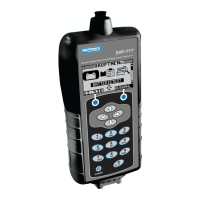• 15 •
Chapter 3: Test Preparation
Inspecting the Battery
Before starting the test visually inspect the battery for:
• Cracked, buckled, or leaking case. If you see any of these defects, replace the battery.
• Corroded, loose, or damaged cables and connections. Repair or replace them as
needed.
• Corrosion on the battery terminals, and dirt or acid on the case top. Clean the case and
terminals using a wire brush and a mixture of water and baking soda.
• Low electrolyte level. If the electrolyte level is too low, add distilled water to fill up to 1/2
above the top of the plates and fully charge the battery. Do not overfill.
• Corroded or loose battery tray and hold-down fixture. Tighten or replace as needed.
Testing Out-of-Vehicle
The preferred battery test location is in the vehicle. However, if you plan to test out of the vehicle:
• Always disconnect the negative cable from the battery first and reconnect it last.
• Always use a carry tool or strap to lift and transport the battery.
Testing In-Vehicle
The preferred test position is at the battery posts. If you must test at a remote-post location, it should
have both a positive and negative post.
At the start of the test, make sure all vehicle accessory loads are off, the key is not in the ignition, and
the doors are closed.
Connecting the Battery Test Cable
CAUTION: Do not connect the tester to a voltage source greater than 30 Vdc.
Connect the battery test cable to the tester by fi rst aligning the cable connector’s 6 pins with the
holes on top of the tester. Firmly insert the connector and tighten the locking ring.
Connect the clamps to the battery: the red clamp to the positive (+) terminal and the black clamp to
the negative (–) terminal.
Chapter 3: Test Preparation

